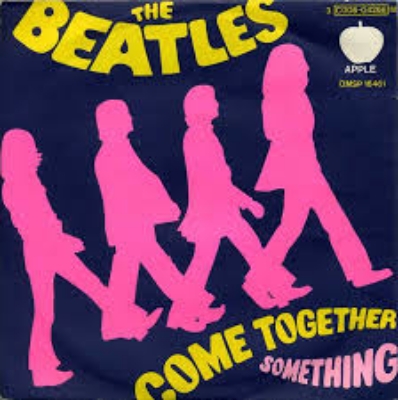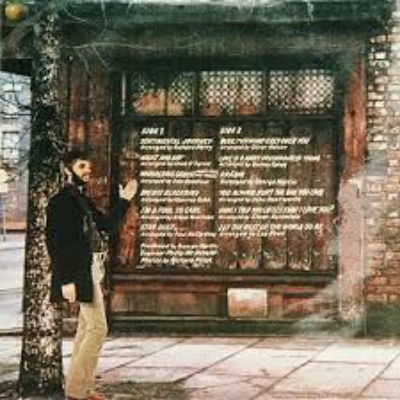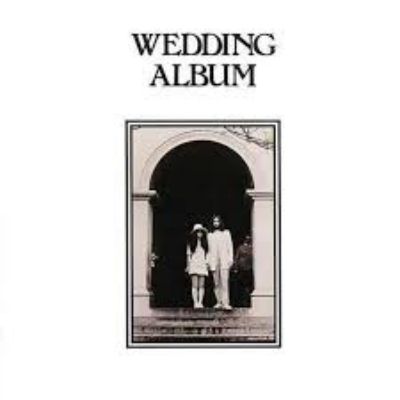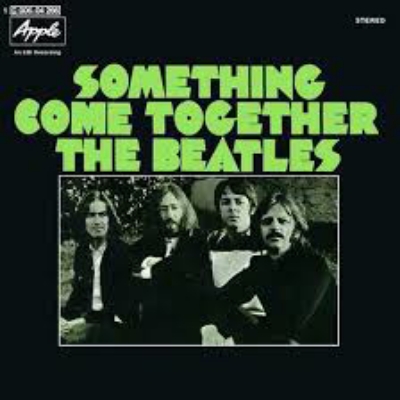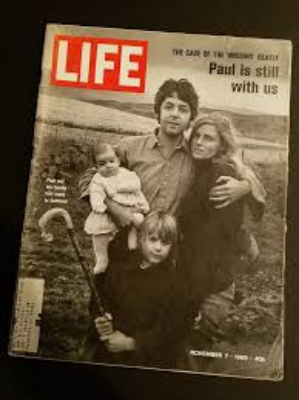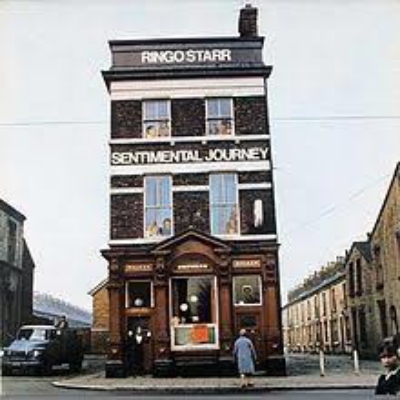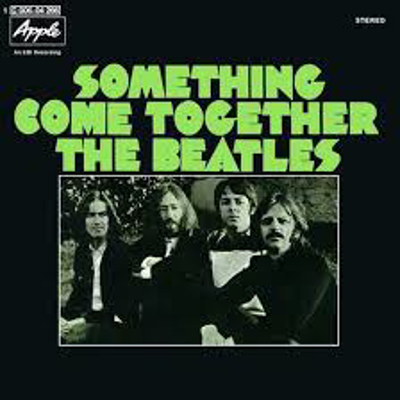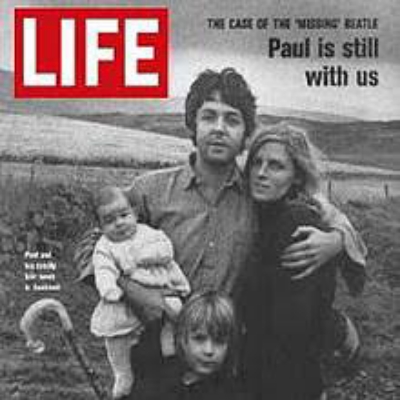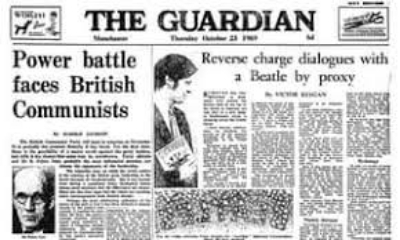Fab Four Blog
New Beginnings for John, Paul, George and Ringo

Sentimental Journey - A rough stereo mixes of two songs recorded for Ringo Starr's debut studio album were made on this day.
Stardust had been recorded on November 7 and 14th, and the backing track for Dream had been taped on the latter date.
Since Dream had not been completed by this date, the mixes were for reference and playback purposes only. Geoff Emerick created them during this mixing session, which lasted just half an hour.

Remembering Abbey Road's "You Never Give Me Your Money"
Did the Beatles have interviews after the break up?
John and Yoko's Wedding Album, the third long player of experimental recordings was released by Apple in the UK on this day.
The couple's first collaboration, Two Virgins, marked the beginning of their relationship and artistic partnership. The follow-up, Life With The Lions, mostly documented their 1968 stay in London's Queen Charlotte Hospital, where Ono suffered a miscarriage.
Wedding Album commemorated their wedding in Gibraltar on 20 March 1969. Although it was the final installment in their trilogy of avant garde and experimental recordings, the couple continued to document their lives on tape until Lennon's death in 1980.
Wedding Album contained just two tracks: John And Yoko and Amsterdam. The release was credited simply to "John & Yoko"; their surnames did not appear anywhere on the sleeve or record labels.
Amsterdam began with Ono singing John John (Let's Hope For Peace). Four other musical interludes were also included: Lennon performing a brief blues-style composition on an acoustic guitar, featuring the words "Goodbye Amsterdam Goodbye"; Ono singing Grow Your Hair, a song about peace and staying in bed, with Lennon on guitar; an a capella rendition of The Beatles' song Good Night; and Bed Peace, a brief recitation of the words "Bed peace" and "Hair peace".

Looks like John and Yoko are getting ready to release an album.
Now that the Beatles have broken up, the lads are getting ready to go solo.
The Beatles are all venturing into their new careers, no longer part of a band.
The Beatles have all gone their separate way. Trying to figure out what's next......
No News to Report Today
Something' the first Beatles A-side composed by George Harrison entered the UK singles chart, it peaked at No.4 in the UK and went on to be a No.1 on the US chart. The song has been covered by over 150 artists, making it the second-most covered Beatles song after 'Yesterday'

Life Magazine published an article on the recent "Paul Is Dead" fiasco. The article contained the now famous clues, select album cover photos, and Paul's own brief comments on the death rumors. Life magazine's London correspondent waded through a Scotland bog to find Paul and Linda at their secluded farm, hoping to be granted a photo or a brief interview.
By this time The Beatles had privately broken up. While the breakup was still a secret and would not be announced for months, Paul states: "The Beatle thing is over." The public and press missed the importance of this passing comment.
Life Magazine spoke briefly with Paul about the various "death clues" including the OPD badge on his Pepper suit (which fans took to mean "Officially Pronounced Dead"), his black flower in Magical Mystery Tour, and his barefooted appearance on the Abbey Road album cover.
PAUL: "It is all bloody stupid. I picked up that OPD badge in Canada. It was a police badge. Perhaps it means Ontario Police Department or something. I was wearing a black flower because they ran out of red ones. It is John, not me, dressed in black on the cover and inside of Magical Mystery Tour. On Abbey Road we were wearing our ordinary clothes. I was walking barefoot because it was a hot day. The Volkswagon just happened to be parked there."
"Perhaps the rumor started because I haven't been much in the press lately. I have done enough press for a lifetime, and I don't have anything to say these days. I am happy to be with my family and I will work when I work. I was switched on for ten years and I never switched off. Now I am switching off whenever I can. I would rather be a little less famous these days."
"I would rather do what I began by doing, which is making music. We make good music and we want to go on making good music. But the Beatle thing is over. It has been exploded, partly by what we have done, and partly by other people. We are individuals-- all different. John married Yoko, I married Linda. We didn't marry the same girl."
"The people who are making up these rumors should look to themselves a little more. There is not enough time in life. They should worry about themselves instead of worrying whether I am dead or not."
"What I have to say is all in the music. If I want to say anything I write a song. Can you spread it around that I am just an ordinary person and want to live in peace? We have to go now. We have two children at home."

Today Ringo Starr had a recording session for his debut album, Sentimental Journey. He taped the song Stormy Weather with George Martin producing.
All this took place at Wessex Sound Studios in London. Ringo Starr had never recorded in the studio before, but several of the sessions were held there.
Stormy Weather, written by Ted Koehler and Harold Arlen, had been a hit in 1943 for Lena Horne. The new version was recorded with 18 musicians, conducted by George Martin, on four-track tape.

Nothing in the news today.
No recording sessions, nothing newsworthy today.
Not much happening today.
November starts with no news.
The first A-side composition by George Harrison as a Beatle, and one of their greatest ballads, was released in the UK today, October 31, 1969. That was when the undying ballad 'Something' was paired with 'Come Together' as the group's new release. On November 8, it hit the chart at a relatively restrained No. 15.

Nothing to report today
No recording sessions were held today.
Today, Ringo Starr began recording his first studio album, Sentimental Journey. He recorded Night And Day in two sessions, with George Martin producing. Night And Day was written by Cole Porter, and had been a 1937 hit for Tommy Dorsey. Starr's version had an arrangement by Chico O'Farrill and was conducted by Martin.
The first session took place from 2.30-5pm and the orchestra recorded the backing track. The 17-strong band featured saxophone, trumpet, trombone, bass guitar, piano and drums. Following a two-hour break for dinner, Starr added his lead vocals in the evening session from 7-9.30pm. With recording complete, Night And Day was mixed into stereo between 9.30 and 10.45pm.
No news to report today
Since the hoax about Paul being dead first surfaced in print back in September (in the Times-Delphic, the newspaper of the Drake University in Des Moines, Iowa), it quickly snowballed. It was featured on the Detroit radio station MKNR. Towards the middle of October it had broken across the Atlantic.
The Beatles were contacted by reporters trying to get an answer. Paul hady travelled to his Scottish farm on October 22nd, and Peter Brown called him to ask for a statement that could be given to the press. McCartney gave a line borrowed from Mark Twain: "Rumours of my death have been greatly exaggerated."
A reporter from New York's WMCA, Alex Bennett, arrived in London on the following day and interviewed Ringo Starr, Derek Taylor, Neil Aspinall, photographer Iain Macmillan, McCartney's tailor and barber, and members of Apple group White Trash. Starr told the Bennett: "If people are gonna believe it, they're gonna believe it. I can only say it's not true."
Then on October 24th, McCartney agreed to speak to the BBC's Chris Drake. The interview took place at McCartney's High Park Farm in Campbeltown, Scotland. McCartney suggested that the stories had begun as he had adopted a lower public profile recently. He said that he once did "an interview a week" to keep in the headlines, but since getting married and becoming a father he preferred to live a more private life.
He was firm in denying he had died, saying: "If the conclusion you reach is that I'm dead, then you're wrong, because I'm alive and living in Scotland." Linda McCartney said their holiday was being ruined by the press speculation, adding that "everybody knows he's alive". Talk then turned to the subject of McCartney's farm, which he admitted was scruffy. He said he had been dubbed "the new Laird" when he first met his Scottish neighbours, but didn't want to be considered the "squire of the district". He concluded the interview by saying that The Beatles had no plans to reconvene in the near future, having recently completed an album and film, and that he may not return to London until 1970.

From the archive, 23 October 1969: Beatles' magical mystery tour leads to Guardian reporter
Rumours that Paul McCartney is dead, which have pushed the Beatles back to the top of the charts in America, are only part of a new surge of Beatlemania which is sweeping across the United States.
I know because, unfortunately, my telephone has proved an all too accurate barometer of the Beatles' popularity in the United States.
Hundreds of people have rung my number day and night from America, where it has a magical significance, asking to speak to characters associated with Beatle songs. This built up to a crescendo in recent days.
"Hallo, can I speak to Sergeant J. Pepper," says a typical voice, courteous, charming - and with the charges reversed.
For months I bravely lost nervous energy in an attempt to discover the secret of why all America wanted to ring me. Late at night I would awake as if in the midst of a nightmare and reach shakingly for the telephone to hear: "I have a collect call for Mr Billy Shears from Chicago, Illinois. Will you accept?"
No calls were accepted, but as they grew more numerous and the American operators more intrigued (I am almost on Christian name terms with some of them), it turned out that I was being rung because of rumours that if you rang a magic number concealed on the sleeve of the "Magical Mystery Tour" album you would be able to hear the Beatles, be translated to mysterious romantic lands, and various other refinements.
The resurgence of Beatlemania in the States is now taking teenagers on a magical mystery tour courtesy of Bell Telephone, which ends iconoclastically at my telephone number.
A girl from California, who did not transfer the charges (she will have to learn the hard way), said she discovered me through gazing at the word Beatles, written in stars on the album sleeve, reversing the image to the mirror, and then reading it backwards.
If you screw your eyes up a bit, and let your imagination roam after a few scotches you can just about squeeze my number, 834 7132, out of it. And if you do not believe this, hundreds of teenagers and others have done just that.
Most of the callers ask for Billy (or Mr William) Shears, who appears on the Beatles' Sergeant Pepper LP, though why they ask for him especially I have never discovered. Others ask for Mr Kite, Mr Henderson ("The Hendersons will all be there"), Ivor Cutler, George Martin, Derek Taylor, and other less familiar names.
John Lennon, Paul McCartney, and George Harrison are frequently asked for, but never Ringo… Now that's the stuff real rumours are made of.
Nightly dialogue
The nightly dialogue is conducted with callers in Chicago, New York, California, Florida, and a host of other States. Over the past few days, as rumours of Paul's death (denied categorically by Apple in London) have mounted, the telephone would have been ringing almost continuously if it were not off the hook.
Most people want to hear that Paul is alive (asking through the operator) and once I confirm that, they refuse to believe that they have come through to the wrong number. One caller asked if Paul was alive and then added: "Can you give me any information about the R and D mortuary."
Yesterday, before leaving for work, I put the telephone back on the hook and it rang almost immediately. A voice with a Southern drawl said: "Hallo, sir, this is John K. Roberts, Radio Corporation of Miami, Florida. Can you tell me and my listeners if Paul McCartney is alive?" And so on and so on.
My favourite was Jane from Milwaukee, whom I shall miss dearly. She had tried the combination 834 7132 on all American exchanges. She told me: "I was sitting by the fire puzzling the quiz out, when I suddenly realised that the number must be in England." She cooled noticeably towards me when I confessed I was not a Beatle, but for a moment or two I knew what idolatry was.
Mythology
In spite of months of questioning I have been unable to trace the origin of the mythology of my telephone number. Most people seem to think it was started by some local radio station and then spread like a forest fire. The only common link of the calls is the consistent use of Beatles song language ("Is it true Paul died Wednesday morning at five o'clock?")
Most callers sound perfectly self-confident, not to say a little "high," and quite unapologetic about ringing up on a transferred charges basis in the middle of the night. On the rare occasions I have been able to question them about how they came to look for a telephone number on the album, they merely say: "Oh I got it from a friend of mine."
Yesterday my magical mystery tour ended. With a feeling of relief, tinged only slightly with regret, I finally decided to get my number changed, severing in one blow a transatlantic link which has been with me on and off for many months.
I rang the operators' supervisor expecting some sympathy for my disturbed nights. Instead she appeared to be thrilled to the bone. "That's marvellous," she said. "You should be able to sell that story to the newspapers for a fortune."
Alas, the unknown penalties of being a newspaper reporter.

- 1970
- 1969
- 1968
- 1967
- 1966
- 1965
- 1964
- 1963
- 1962

